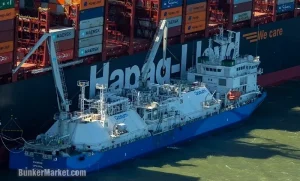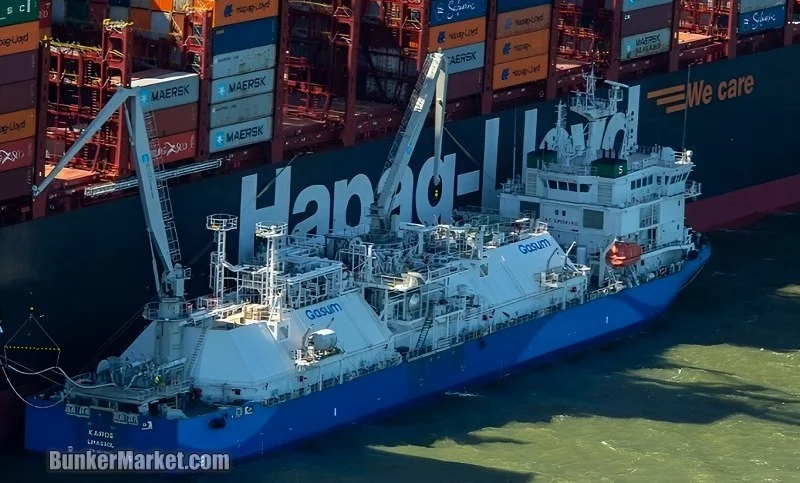In 2024, the maritime industry reached another defining moment in its ongoing journey toward decarbonization. Hapag-Lloyd, one of the world’s leading container shipping companies, partnered with the Zero Emission Maritime Buyers Alliance (ZEMBA) to advance the use of biomethane as a sustainable fuel. This deal is not just a contractual agreement between a shipping line and a buyer coalition — it is a symbol of how the shipping sector is slowly but steadily reshaping itself under the pressure of regulatory targets, environmental expectations, and market demand for low-carbon logistics.
Shipping is responsible for about 2–3% of global greenhouse gas emissions, roughly equal to the carbon footprint of a major industrialized nation. Without significant action, this figure could rise to nearly 5–8% by 2050, according to the International Maritime Organization (IMO). Against this backdrop, fuel choice has emerged as the most critical factor for achieving the sector’s decarbonization goals. The debate is no longer about whether ships will need alternative fuels, but rather which fuels will dominate, how they will be sourced, and who will lead in building the infrastructure to support them.
This is where Hapag-Lloyd’s collaboration with ZEMBA takes center stage. ZEMBA is a buyer-led coalition formed by major shippers and cargo owners, including global brands committed to reducing the carbon footprint of their supply chains. By pooling demand for green fuels, ZEMBA strengthens the business case for shipping companies to adopt new fuels, thereby bridging the notorious “chicken-and-egg” problem of supply and demand in maritime energy transitions.

Credit: https://bunkermarket.com/hapag-lloyd-achieves-bio-methane-milestones-under-zemba-initiative/
Biomethane — a renewable gas derived primarily from organic waste — offers a compelling case in this equation. It has the potential to deliver immediate greenhouse gas reductions while using infrastructure already developed for liquefied natural gas (LNG). For shipping lines like Hapag-Lloyd, this means an opportunity to scale low-carbon operations without waiting decades for hydrogen or ammonia supply chains to mature.
Yet the story is not without challenges. Biomethane supply remains limited, its certification systems are still evolving, and questions linger about whether it is a transitional fuel or a long-term solution. Nevertheless, the Hapag-Lloyd–ZEMBA deal marks a pivotal case study in how strategic partnerships can accelerate fuel innovation and provide valuable lessons for the entire maritime sector.
In this article, we will take a comprehensive look at the significance of this deal, the technical and regulatory context behind biomethane as a marine fuel, the barriers still to be overcome, and the future prospects of such collaborative models. We will also draw on real-world examples, regulatory insights, and technological updates to provide a complete perspective on what this development means for the industry and for global trade.
Why This Topic Matters in Maritime Operations
The shipping industry is at a crossroads. On one side lies the entrenched reliance on heavy fuel oil (HFO) — long the backbone of marine propulsion due to its low cost and global availability. On the other lies an urgent call for sustainability, driven by climate science, regulatory frameworks, and stakeholder pressure. The deal between Hapag-Lloyd and ZEMBA encapsulates this turning point. To understand its significance, we must explore the broader reasons why this subject matters deeply to maritime operations today.
1. The Scale of Shipping’s Carbon Footprint
Commercial shipping moves over 80% of global trade by volume. The same efficiency that makes shipping the least carbon-intensive mode of transport per ton-kilometer also means that its absolute emissions are massive. According to the Fourth IMO GHG Study (2020), international shipping emitted roughly 1,076 million tonnes of CO₂ in 2018. If considered as a nation, shipping would rank among the top 10 global emitters.
This scale makes decarbonization efforts in shipping not just a maritime concern but a global environmental imperative. Unlike aviation, which is visible to consumers, shipping’s emissions occur largely out of sight on the high seas. Yet every container filled with consumer goods, industrial inputs, or food products leaves an invisible carbon trail. The growing awareness among businesses and consumers about supply chain emissions has forced shipping companies to rethink their environmental strategies.
2. Regulatory Pressure and IMO Targets
Regulation is one of the strongest drivers behind the shift toward green fuels. The IMO has committed to reaching net-zero GHG emissions from international shipping “by or around 2050.” Interim checkpoints include reducing emissions intensity by at least 40% by 2030 and 70% by 2040 compared to 2008 levels. To achieve these goals, ships must shift to low- or zero-carbon fuels at scale.
In parallel, regional regulations such as the EU Emissions Trading System (ETS) and the FuelEU Maritime regulation are exerting immediate financial pressure. Starting in 2024, shipping companies operating in Europe are required to purchase carbon allowances for a portion of their emissions. FuelEU Maritime, taking effect in 2025, will mandate the gradual uptake of renewable and low-carbon fuels. These policies create a business case for shipowners to act early, as failing to comply could result in financial penalties and competitive disadvantage.
For companies like Hapag-Lloyd, adopting biomethane early through collaborations with ZEMBA is not merely an environmental choice — it is also a strategic move to stay ahead of tightening regulations and to present a greener offering to customers.
3. Market Expectations and Cargo Owners’ Role
Beyond regulators, another powerful force shaping maritime fuel choices is the cargo owner — the companies that charter vessels to move their goods. In recent years, major multinationals including Amazon, IKEA, and Unilever have pledged to decarbonize their supply chains. ZEMBA, formed in 2022, embodies this shift by creating a buyer-driven demand pool for zero-emission shipping solutions.
The Hapag-Lloyd–ZEMBA biomethane deal illustrates how cargo owners are no longer passive clients of the shipping industry. Instead, they are active participants shaping fuel choices, infrastructure investments, and innovation pathways. For maritime operations, this represents a significant change in stakeholder dynamics. Shipowners must now consider not only compliance with regulations but also the preferences of customers who demand verifiable reductions in emissions.
4. Technology Readiness and Infrastructure Synergies
From a technological perspective, biomethane offers a practical advantage. It can be liquefied (bio-LNG) and transported using the same infrastructure as fossil LNG. Many shipping companies, including Hapag-Lloyd, have already invested in LNG-ready vessels. By switching from LNG to bio-LNG, they can reduce lifecycle emissions without undertaking costly retrofits or building entirely new bunkering systems.
This dual compatibility makes biomethane particularly attractive in the short to medium term. For maritime operations, where the lifespan of ships often exceeds 25 years, fuel flexibility is critical. An LNG-powered ship today can evolve into a bio-LNG ship tomorrow, and potentially a synthetic methane vessel in the future. Such adaptability is essential in a market where fuel technologies are still competing for dominance.
5. The Economics of Green Shipping
Finally, economics cannot be ignored. Shipping is a cost-sensitive industry operating on tight margins. Green fuels generally come at a premium compared to conventional HFO. For biomethane, costs remain significantly higher than fossil LNG, largely due to production limitations and certification costs.
However, partnerships like the Hapag-Lloyd–ZEMBA deal are designed to address this challenge. By pooling demand from cargo owners and creating forward contracts, ZEMBA helps stabilize demand and reduce investment risks for fuel producers. This, in turn, supports economies of scale that can gradually bring prices down.
For maritime operators, early adoption also opens doors to green financing, subsidies, and preferential treatment in ports and logistics contracts. Thus, the economics of biomethane adoption is not just about fuel costs but about long-term competitiveness in a decarbonizing global trade environment.
Transition to Next Section
The reasons outlined above — carbon intensity, regulatory frameworks, market expectations, technological synergies, and economics — explain why the Hapag-Lloyd–ZEMBA biomethane deal matters far beyond the companies directly involved. It is a microcosm of the broader transformation underway in the shipping industry.
In the next section of this article, we will dive into Key Developments, Innovations, and Technologies driving this shift, with a closer look at how biomethane compares with other alternative fuels, what makes it unique, and how partnerships like ZEMBA are reshaping maritime fuel strategies.

